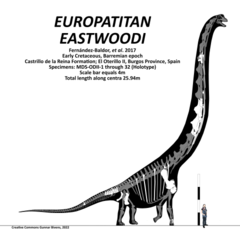
Andesaurus is a genus of basal titanosaurian sauropod dinosaur which existed during the middle of the Cretaceous Period in South America. Like most sauropods, belonging to one of the largest animals ever to walk the Earth, it would have had a small head on the end of a long neck and an equally long tail.
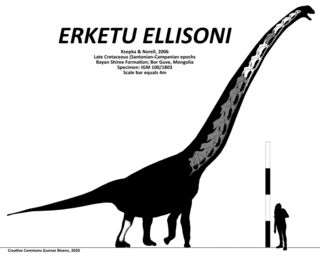
Erketu is a genus of somphospondylan sauropod dinosaur that lived in Asia during the Late Cretaceous roughly between 96 million and 89 million years ago. Its fossils were found in Mongolia between 2002 and 2003 during a field expedition and first described in 2006; later on in 2010 due to some cervicals that were left behind in the expedition. Erketu represents one of the first sauropods described from the Bayan Shireh Formation. The elongated cervical vertebrae of Erketu indicates that it was the sauropod with the longest neck relative to its body size.
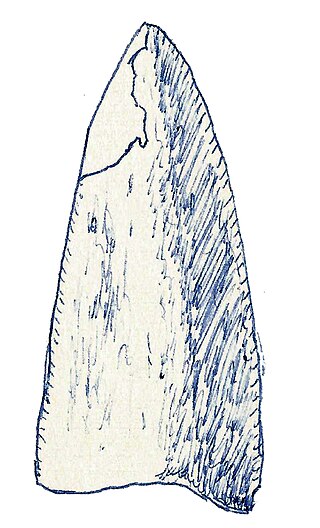
Mongolosaurus is a genus of titanosauriform sauropod dinosaur which lived during the Early Cretaceous of China.

Pukyongosaurus is a genus of titanosauriform dinosaur that lived in South Korea during the Early Cretaceous period. It may have been closely related to Euhelopus, and is known from a series of vertebrae in the neck and back. The characteristics that were originally used to distinguish this genus have been criticized as being either widespread or too poorly preserved to evaluate, rendering the genus an indeterminate nomen dubium among titanosauriforms. The 2022 study noted that Pukyongosaurus is probably a somphospondylan.

Ligabuesaurus is a genus of somphospondylan sauropod dinosaur from the Early Cretaceous that lived in what is now Argentina. The type species, Ligabuesaurus leanzai, was described by Jose Bonaparte, Gonzalez Riga, and Sebastián Apesteguía in 2006, based on a partial skeleton with skull, holotype MCF-PHV-233. The generic name, Ligabuesaurus, honors Giancarlo Ligabue, while the specific name, leanzai, honors the geologist Dr. Héctor A. Leanza, who discovered the skeleton in the Lohan Cura Formation. In 2022, a second skeleton was referred, specimen MCF-PHV-228. A third skeleton was recovered but not referred due to a lack of overlapping material. The three skeletons were excavated between 1998 and 2000.

Tastavinsaurus is a genus of sauropod dinosaur belonging to the Titanosauriformes. It is based on a partial skeleton from the Early Cretaceous Xert Formation of Spain. The type species is Tastavinsaurus sanzi, named in honor of the Rio Tastavins in Spain and Spanish paleontologist José Luis Sanz. Tastavinsaurus sanzi is known from two specimens, one from the Xert Formation and one from the Forcall Formation. Tastavinsaurus was originally described as a somphospondylan, but it may be a brachiosaurid. The clade Laurasiformes was coined for Tastavinsaurus and its close relatives, which may include Cedarosaurus, Soriatitan, and Venenosaurus.

The Urbión Group is a geological group in Castile and León and La Rioja, Spain whose strata date back to the Early Cretaceous (late Hauterivian to late Barremian. The formations of the group comprise a sequence of brown limestones in a matrix of black silt, sandstones, claystones and conglomerates deposited under terrestrial conditions, in alluvial fan and fluvial environments.
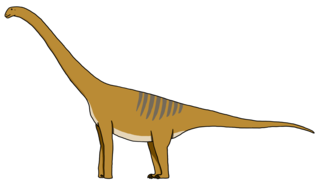
Arkharavia is a dubious genus of somphospondylan sauropod, but at least some of the remains probably belong to a hadrosaurid. It was discovered in the Udurchukan Formation in Russia and lived during the Late Cretaceous. It was described in 2010 by Alifanov and Bolotsky and the type species is A. heterocoelica.
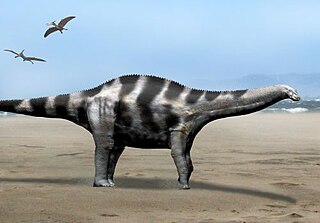
Demandasaurus is a genus of rebbachisaurid sauropod dinosaur from early Cretaceous deposits of Spain. Demandasaurus is known from an incomplete but associated skeleton that includes cranial and postcranial remains. It was collected from the Castrillo de la Reina Formation in Burgos Province of Spain. It was first named by Fidel Torcida Fernández-Baldor, José Ignacio Canudo, Pedro Huerta, Diego Montero, Xabier Pereda Suberbiola and Leonardo Salgado in 2011 and the type species is Demandasaurus darwini.

Astrophocaudia is a genus of somphospondylan sauropod known from the late Early Cretaceous of Texas, United States. Its remains were discovered in the Trinity Group. The type species is Astrophocaudia slaughteri, described in 2012 by Michael D. D’Emic while a doctoral student at the Museum of Paleontology of the University of Michigan, USA.
Arcanosaurus is an extinct genus of varanoid lizard from the Early Cretaceous of Spain. It is known from 29 vertebrae that were found disarticulated but close together in a fossil locality called Viajete in the province of Burgos. The bones were found within a layer of the Castrillo de la Reina Formation, which dates back to the late Barremian and early Aptian stages of the Early Cretaceous. The vertebrae of Arcanosaurus share several features in common with those of other varanoid lizards, but they lack bony projections called posterior hypapophyses that are found in nearly all other varanoids.
Yunmenglong is an extinct genus of somphospondylan sauropod known from the late Early Cretaceous of Henan Province, central China. Its remains were discovered in the Haoling Formation of the Ruyang Basin. The type species is Yunmenglong ruyangensis, described in 2013 by Junchang Lü et al. on the basis of an incomplete postcranial skeleton. Yunmenglong shares some characters with Euhelopus, Qiaowanlong and Erketu, and a phylogenetic analysis places it as a sister taxon of Qiaowanlong, both grouped with Erketu in a position more derived than Euhelopus but basal to Titanosauria.
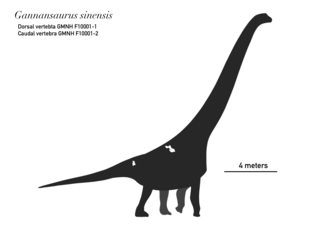
Gannansaurus is an extinct genus of somphospondylan sauropod dinosaur known from the latest Cretaceous Nanxiong Formation of Ganzhou Basin, Jiangxi Province of southern China. It is known from specimen GMNH F10001 which consists of a single, nearly complete dorsal vertebra and a mid-caudal vertebra. Gannansaurus was first named by Lü Junchang, Yi Laiping, Zhong Hui and Wei Xuefang in 2013 and the type species is Gannansaurus sinensis. Gannansaurus shares some characters with Euhelopus, indicating that it is more closely related to it rather than to other titanosauriforms.

Padillasaurus is an extinct genus of titanosauriform sauropod known from the Early Cretaceous Paja Formation in Colombia. It contains a single species, Padillasaurus leivaensis, known only from a single partial axial skeleton. Initially described as a brachiosaurid, it was considered to be the first South American brachiosaurid ever discovered and named. Before its discovery, the only known brachiosaurid material on the continent was very fragmentary and from the Jurassic period. However, a more recent study finds it to be a basal somphospondylan.
Triunfosaurus is a genus of somphospondylan sauropod dinosaur from the Early Cretaceous of Brazil. It contains a single species, T. leonardii, described by Carvalho et al. in 2017. As a genus, Triunfosaurus can be distinguished from all other titanosaurs by the unique proportions of its ischium. It was initially described as a basal titanosaur, making it the earliest basal titanosaur known; however, subsequent research questioned the identification of the taxon as a titanosaur, instead reassigning it to the Somphospondyli.
The Castrillo de la Reina Formation is a geological formation in Spain. It is late Barremian to early Aptian in age. It interpreted as a fluvial deposit. It primarily consists of red clay, with ribbon shaped sandstone channel fills. The rebbachisaurid dinosaur Demandasaurus occurs in the formation, alongside somphospondylan Europatitan as well as indeterminate small ornithopods, iguanodonts and spinosaurids, the earliest known stem-rhabdodontid (indeterminate) and the lizard Arcanosaurus.
Ninjatitan is a genus of titanosaur sauropod dinosaur from the Early Cretaceous (Berriasian-Valanginian)-aged Bajada Colorada Formation of Argentina. It is the oldest titanosaur known to date and the type species N. zapatai was named and described in 2021. Its generic name comes from a nickname of Argentine palaeontologist Sebastian Apesteguia, and the specific name comes from technician Rogelio Zapata. It is known from postcranial remains discovered in 2014.

Australotitan is an extinct genus of possibly titanosaurian somphospondylan dinosaurs from the Late Cretaceous Winton Formation (Cenomanian–Turonian) of southern-central Queensland, Australia. The genus contains a single species, A. cooperensis, known from multiple partial skeletons. The genus Australotitan may be synonymous with Diamantinasaurus, a contemporary relative.

Jiangxititan is an extinct genus of somphospondylan titanosauriform dinosaur from the Late Cretaceous Nanxiong Formation of China. The genus contains a single species, J. ganzhouensis, known from several articulated vertebrae with ribs. Originally described as a titanosaur, Jiangxititan was later suggested to be a non-titanosaurian somphospondylan.

Garumbatitan is an extinct genus of somphospondylan sauropod dinosaur from the Cretaceous Arcillas de Morella Formation of Spain. The genus contains a single species, G. morellensis, known from multiple partial skeletons.
